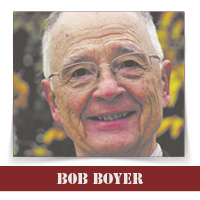By: Bob Boyer
Perhaps a better title would be “Insights into Philippine Culture Through Selected Language Tidbits.” The following examples are the ones I chose from my book, “Sundays in Manila,” as part of an introductory lecture about the Philippines. As I mentioned in an earlier column, I gave the talk a few months ago to a group of over fifty people in a Learning in Retirement Program course at the UW-Green Bay campus.
The first three words in my list in capital letters below reflect the current economic reality of the country. Roughly ten-percent of the 100 million Filipinos work full-time in a foreign country. They earn considerably more than they could at home and send money back to support their families. As a country of 800 or so inhabited islands, the Philippines has always had lots of comings and goings among the islands and with other lands. In recent times, however, the number of people who are absent for long periods of time has increased greatly. Making the best of the situation, Filipinos turn the homecoming visits into big celebrations.
OFW: Over ten percent of the annual income of the Philippines comes from “Overseas Filipino Workers.” For example, many women work as nannies or house cleaners, many of the men in various capacities on merchant navy or cruise ships.
BALIKBAYAN: Homecoming or by extension, the person coming home.
PASALUBONG: Gifts, what is in the balikbayan box. I have seen boxes or crates with gifts, large and small, including television sets, washers and dryers, and refrigerators. They all somehow made the trip and emerge along with the extra-large sized suitcases at the baggage-claim areas. Relatives and friends with large welcome-home banners wait for their OFW relatives with all the excitement of Christmas Morning. The next three words speak eloquently in my opinion of the historical and contemporary importance of women in the Philippines.
BINIBINI: (Respectable) Young Lady. I have invariably been rewarded with a sparkling smile or a pleasant ‘thank you’ from polite young Filipinas when I greet them with “binibini.” The same root appears in the next word.
LAKAMBINI: Muse, beauty queen, female chief, great chief.
INANG BAYAN: Mother Goddess, Motherland. The following two names further underline the significance of women. They link traditional Philippine religious with later Christian belief in Mary, the mother of Jesus.
MARIA MAKILING: Mythical figure associated with Mt. Makiling in Laguna Province. Mt. Makiling is an easy and rewarding climb even for old people like me.
PEREGRINATING VIRGIN: Mythical/Religious figure reportedly encountered, especially in times of need, near the town of Silang in Cavite Province. I’ve explored woods and streams there but can’t report a sighting, but then I didn’t have a special need. The concluding language tidbits are words I found particularly useful as well as culturally meaningful as I experienced them.
SAAN: I stopped to ask an elderly gentleman if he would direct me to the post office on the UP campus. He wouldn’t answer until I came up with something, anything, in Filipino I then knew. Fortunately he let me get away with “saan (where) post office.”
MABUHAY: On a visit to my college (St. Norbert), former President Fidel Ramos, opened his talk with “mabuhay” and went on to explain that, depending on the context, it means “hello, goodbye, how are you, happy Mother’s Day, happy birthday, Merry Christmas, etc.”
INGAT: When I said “paalam” (goodbye) to one of my UP students, she was offended and taught me to use the much warmer “ingat,” which means “stay well until we meet soon again.” Perhaps I should end each of these articles with “Ingat.” ##
Contact Bob Boyer at www.anamericaninmanila or Robert.boyer@snc.edu.
 VIA Times – May 2015 Issue Vital News, Vibrant VIews for Asian Americans in Chicago & Midwest
VIA Times – May 2015 Issue Vital News, Vibrant VIews for Asian Americans in Chicago & Midwest




